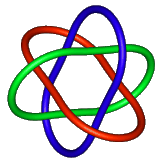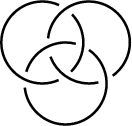|
|
|
|
|
|
|
|
|
|
|
|
Shinto Symbols of Three-ness
|
|
|
|
|
|
|
|
|
|
|
|
The mitsu or triple tomoe, shown above, adorns the walls and flags of Kora Taisha Shrine where I live. I have asked the shrine priest about their meaning but they were unable to be specific. The mitsu tomoe often appears on the surface of drums and the ends of corner roof tiles. Tomoe may swirl in either directions. Some families use them as their family crest. There are single, and double Tomoe (like the Taoist yin-yang symbol) and quadruple ones as well, but the mitsu or triple tomoe are particularly identified with Shinto. This page considers how the Tomoe represents a fundamental dimension of the Shinto world view.
The Three Part Structure of Shinto Mythology
The Shinto world-view is often argued to
be (like the Catholic) tripartite - it forms a trinity or three tiered
structure and this is evidenced in a number of ways. Firstly, Gods
are classified according to a bipartite structure; there are gods of the
heavens, gods of the earth. With the addition of the mundane world this
becomes a three-part classification. Secondly Shinto mythology is often
structured as taking place between three worlds. Such worlds include -
|
|
|
|
|
|
|
|
|
|
|
|
|
|
|
Thirdly, gods often appear in the mythology
in a threesomes. Such trios of gods include
|
|
"God Ruling the Center of Heaven." |
|
|
|
|
|
|
|
|
|
The Dictionary of Basic Shinto Terms, provided by Kokugakuin University writes about the first trinity in the following way -
Takamimusubi no kami is related to the gods of heaven, while Kamimusubi no kami is related to the gods of earth. These two gods, together with Amenominakanushi no kami, are the three gods (zoka no sanshin) mentioned in the Japanese myth of creation. The Kojiki relates that they appeared at the beginning of the creation of heaven and earth and were the basis for the birth and growth of all things. Amenominakanushi no kami means "God Ruling the Center of Heaven." Many Shinto scholars have held that all the gods of Shinto are merely manifestations of this one deity. In the movement to organize Shinto at the beginning of the Meiji period, these three deities, together with Amaterasu Omikami, were considered to be the highest gods; many Shinto sects maintain this view. (musubi)
It has been argued that this tripartite division of the gods into three is universal however, corresponding to divisions in society -- warriors, priesthood and agriculture. When this (German) theory of (Indian/Aryan) mythology was applied to Japanese mythology by Yoshida Astuhiko and others, it was argued that the same tripartite distinctions exist in Japanese society too. It is true that the Edo period Japanese caste system was tripartite, made up of Warriors, Agricultural peasants and tradesmen in that order.
More interestingly, however, Jungian psychologist Kawai Hayao remarked upon the fact that one member of each trio does absolutely nothing in his "empty centred structure" theory of Japanese myth and culture. The God that does nothing represents, he argues, the "Empty Centre" about which various poles - such as male and female, master and slave, land and sea - conflict but then ultimately maintain a harmony. Kawai develops this idea in his book "Kuuchuukouzou nihon no Shinsou" which was popular at the time of its release and help to make Kawai Hayao one of the most famous academics in Japan. The theory would seem to imply however that, for example, the moon god is some how the centre of the Japanese Panthenon, an assertion that many Shinto academics would find hard to accept. It may be possible to find Kawai Hayao's book "Kuuchuukouzou nihon no Shinsou" as a book rental at your local library if you're interested in reading more about his theory.
The Interdependence of the Shinto Trinity
The Taoist and Confucian yin and yang symbol, which is very similar to a double tomoe, is used to express the mutual complemetarity of the yin and the yang. The symbols for the yin and the yang are "contained in one circle, showing that both powers are in one cycle. Instead of these two being held in antagonism, they are held together to show the that they are mutually interdependent partners. One cannot exist without the other." (Yin-Yang)
 |
 |
|
|
|
It is probable that the triple tomoe symbol also symbolises the interdependence of each of its three parts.
As it is often pointed out, Western thought often tends to stipulate mutually exclusive and independent opposites. One is lead to suppose that Good exists independently of Evil. Against this, it is often pointed out that eastern philosophy is tends to envisage opposites as being mutually interdependent. Good is that which is not evil, masculine is that which is not feminine, each pole is mutually dependent upon and complimentary to its opposite. In Shinto, however, fundamental relationships are not bipartite by tripartite, and these are considered to be interdependent. This outlook is emphasises only actors in any situation but the environment or field in which this relationship takes place. In Shinto, the interaction opposites is understood as one of mutual independence or of mutual complementarity not only upon each other, but also with a third term that of the space or the environment wherein the relationship exists. Thus it is with social relationships in Japan - they are not defined solely by the characteristics of the individuals taking part but also upon the space or place where they situated.
The Shinto Trinity and Jacques Lacan's Theory of the Human Psyche
I have analysed the Shinto trinity using the Lacanian distinction between the imaginary, symbolic. Lacan also considered the three parts to his worldview to be mutually independent and used Borromean rings to signify this interdependence. Despite that fact that no two rings are linked, if one of the rings is cut, all three rings fall apart.



The Lacanian real is defined as stuff of existence, and as such the stuff or materiality of all signs, and the unknowable thing in itself in the absence of signification. This may be argued to correspond to the empty centre of the Shinto trinity and the Shinto vision of the reality of Japan itself. The Lacanian symbolic refers to the world of language, which creates the world as we conceive it. For Lacan, this world is dominant. This may be argued to correspond to the Shinto "Takamagahara" or "plain of heaven." This is the world of the Imperial gods of heaven a described by Japanese mythology. For the most part there is little visual description of Heaven. But it acts as the source of holy, verbal orders to bring an imperial and ultimately patriarchal order to the world. The Lacanian imaginary corresponds to the iconic or the Barthian sign: the world of visual symbols, such as the faces, images of body parts, and images in dreams. This may be argued to correspond to the world of the Kunitsu Kami, the gods of the earth, the old gods of nature, that function as culturally defining symbols, at least prior to the arrival of a master language.
Both the worlds of Shinto and and the domains of the Lacanian trinity are separate, yet structurally inter-dependent. As none of the three rings in the above diagram penetrate any of the others, so the three domains are mutually exclusive and separate. At the same time if any of the rings is cut, the structure falls apart - they are interdependent. It is easy to see why both the imaginary and symbolic are dependent upon the real. There could be no symbol or image of any sort nor anything to be structured by its action, if there were no stuff of the sign. It is not entirely clear why there could not be a world which was only structured by language. And Lacan argues that there is a world, for the infant, which is only structured by imaginary identifications. Nonetheless, the psychology of the adult human, Lacan argues, is dependent upon both symbolic and imaginary signification - both images and words are made up of, and structure the unknowable void of the real, into the knowable human world of reality.
The Gods of the Earth might be also theorised using Lacan's theory of "points de caption". Lacan argues that their are specific privelidged signs such as the phallus that are taboo and anchor symbolic structures.
Lacan's theory of tripartite structure of the psyche is no doubt in part a product of his Catholic culture and upbrining. In Lacanian theory the symbolic hold pride of place in the structure as, it may be argued, does the logos in Christian theology. In Shinto it would seem that the wheel is able to turn. If you ask a priest that has graduated from Kokugakuin University, he will probably tell you that Shinto, like Christianity places the most emphasis on the "Gods of Heaven", written mythology as scripture, and written prayer. From a Western perspective, however, Shinto can appear to present an abundance of the imaginary, of visual signs that represent power and authority. From the buttonhole pins of to the Japanese mafia Yakuza members, to the tasteless but visually exquisite national dish, Sushi, it often seems to a Westerner that the symbol-as-image is predominant in Japan. This may be unfair to Shinto. Shinto may claim to maintain a balance between the symbolic and the imaginary. This is also a balance that is never far from the real "stuff of the sign", away from what Nishida Tetsurou called "pure experience" or perhaps, the experience of purity.
The possible correspondence between the
Shinto cosmology and Lacanian theory is shown in the following table.
| Lacanian domain |
|
|
|
| Characterisics of above | The bodily image, dream symbols, other visual symbol, binary relationships, agression. | The stuff of the sign, the unsymbolised stuff of existence. | Language, patriarchy. |
| Shinto Cosmology |
|
|
|
| Characteristic God |
|
|
|
Triple Interdependence in other Religious Traditions
Apart from the Catholic trinity, symbols
similar to the Borromean rings are found in Scandinavian religion as in
intersecting triangular on this Rune
Stone, showing the 'Star of Wotan' and in the square engravings on
Zoroastrian
temples.